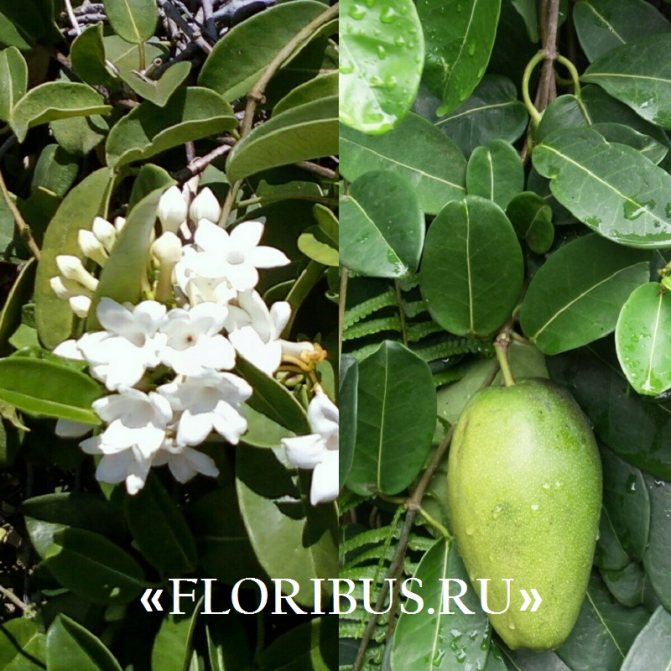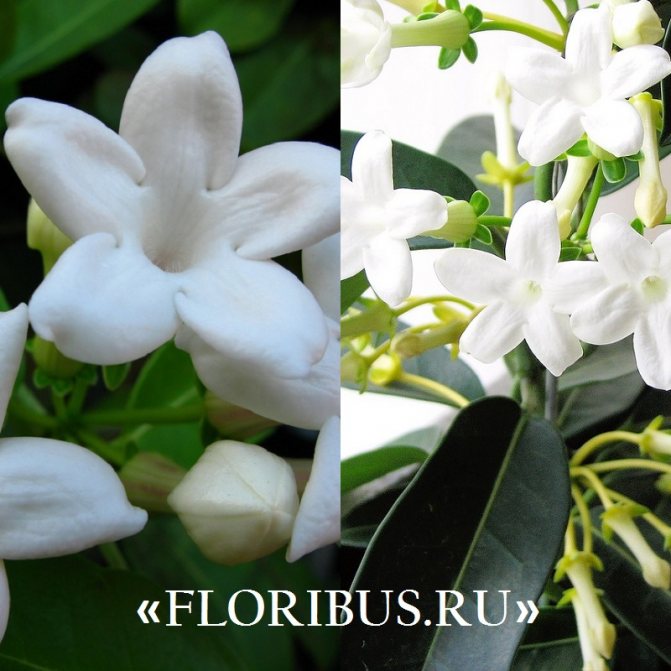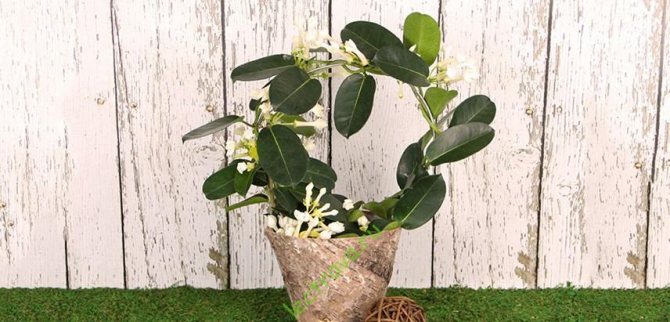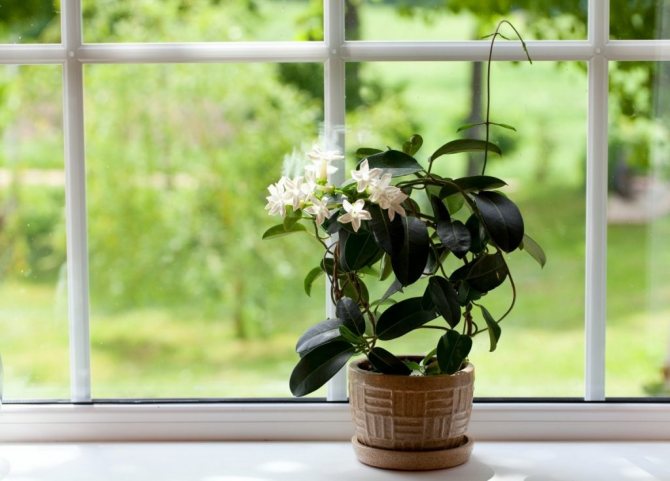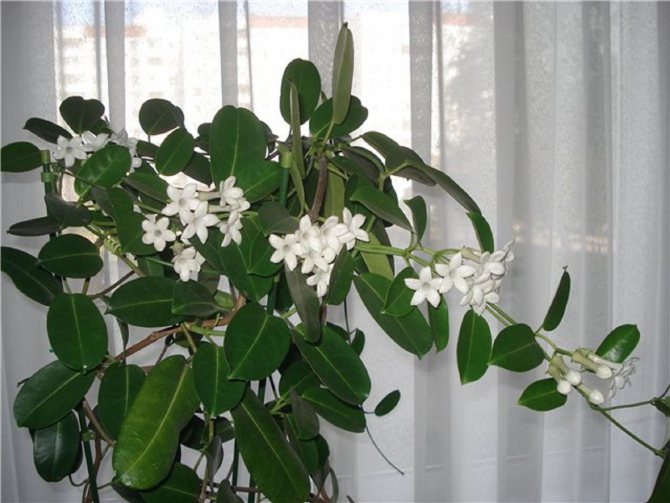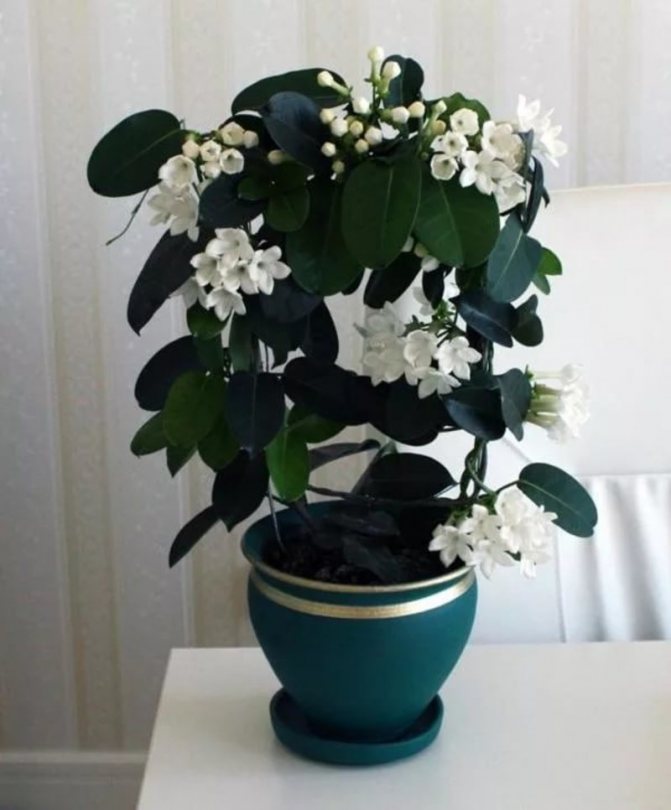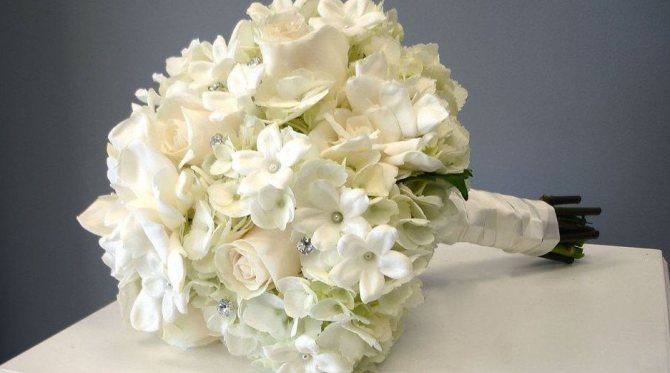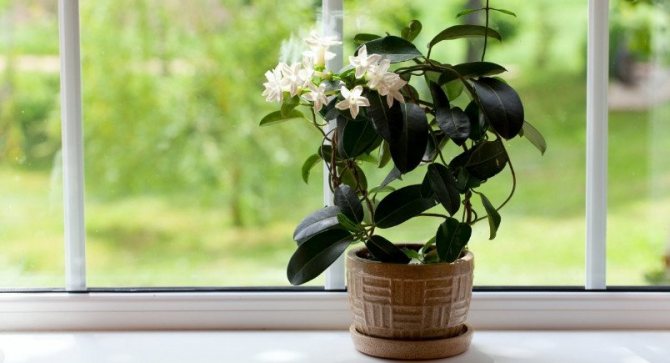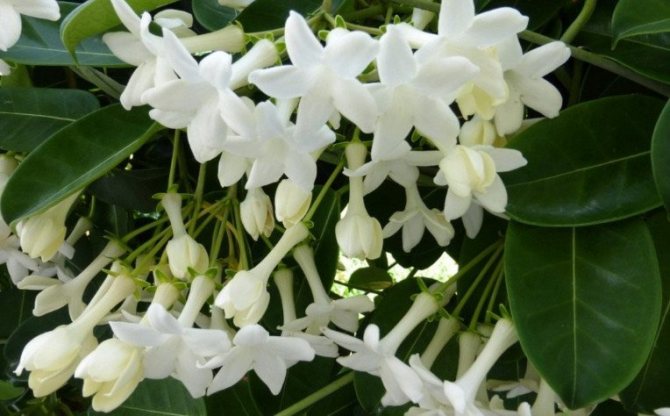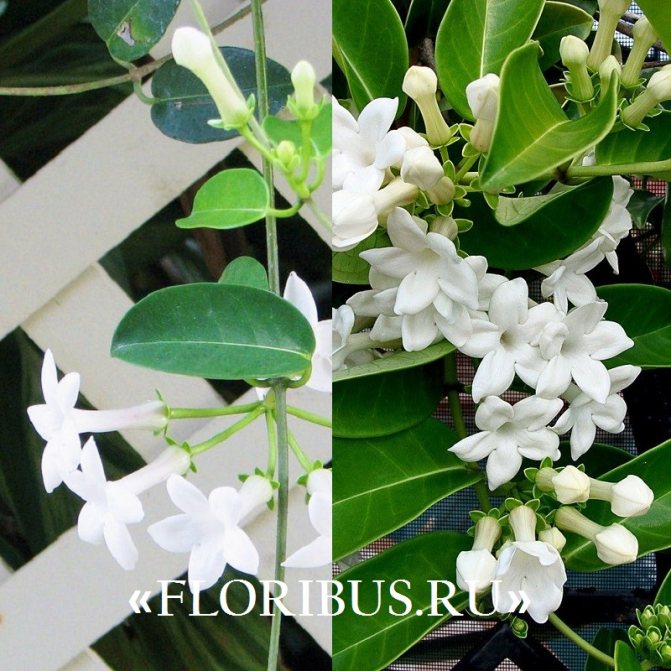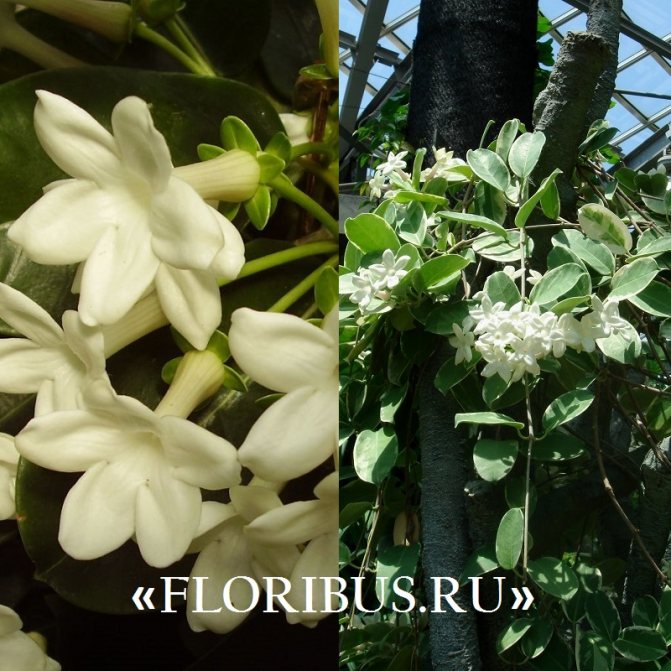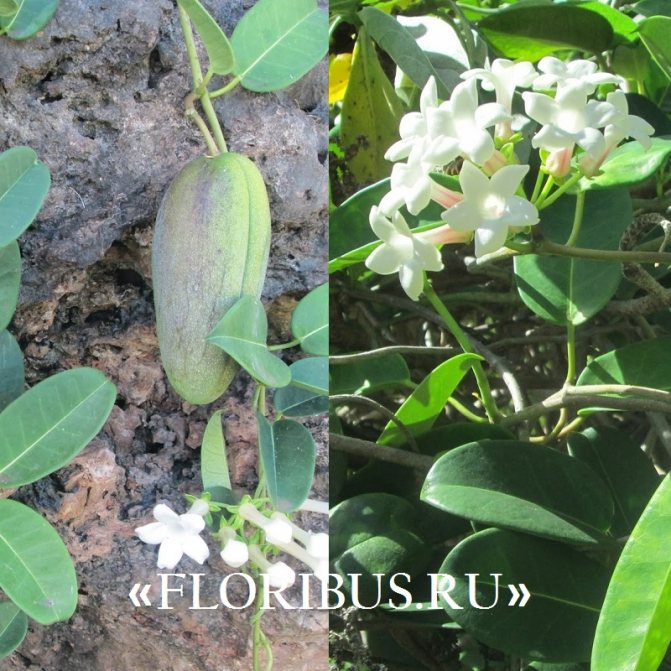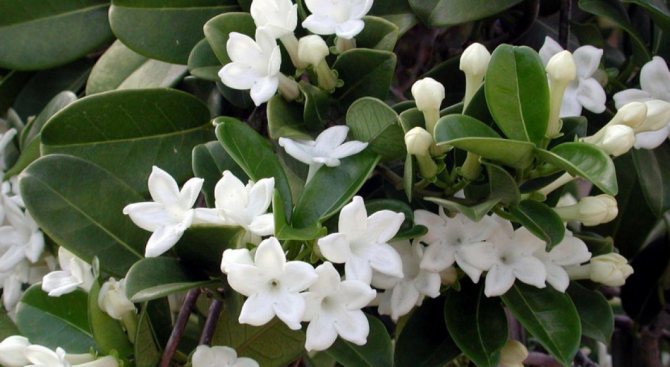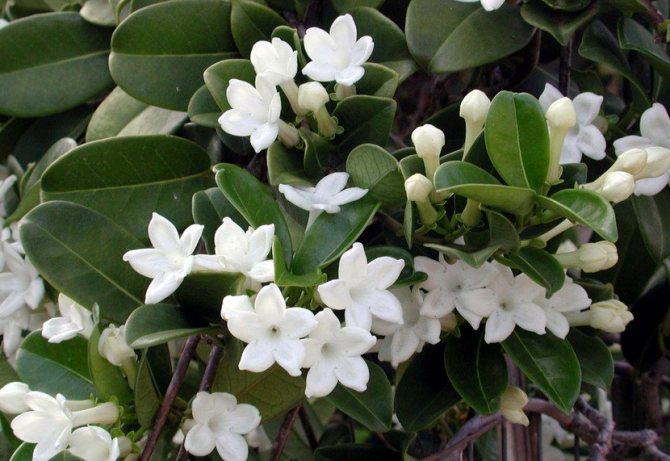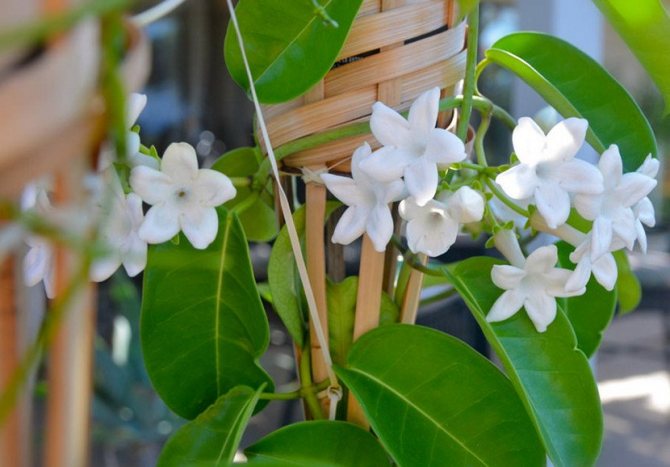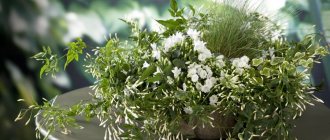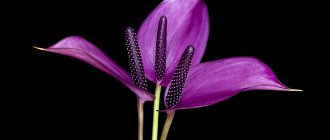Photo Stephanotis (Stephanotis) - evergreen flowering vine from the Lastovne family... A perennial plant appeared on the island of Madagascar. In the wild, it is found in the tropical forests of China, Malaysia. Stephanotis grows rapidly, each year increasing the length of the climbing shoots by 60 cm.In nature, they can reach 6 m, at home they grow no more than 1 m.The plant blooms in May, and all summer, against the background of dark green leathery leaves, umbrella inflorescences of snow-white flowers. Sometimes flowering is repeated in September.
The stamen tube of the flower is crowned, like a crown, with 5 petals. Each of them is shaped like a pig's ear. Comparison with the animal gave the main name of the flower. The word stephanotis has Greek roots and is translated as “a crown of ears”. The delicate aroma and star-shaped flowers are reminiscent of jasmine. Associations with him and the origin of the plant influenced the emergence of another name for Stephanotis - Madagascar jasmine.
| Average growth rate, up to 60 cm per year. |
| It blooms from late spring to early autumn, against the background of dark green leathery leaves, umbrella inflorescences of snow-white flowers stand out |
| The plant is grown with little difficulty. |
| Perennial. |
Lighting.
plant. Flowering is possible only if direct sunlight falls on it. In summer, liana is best grown in the east or west window. In winter, Stephanotis needs as much light as possible, so at this time of the year it is placed on the window sill. Flowering occurs with long daylight hours, that is, with natural light - in summer. When illuminated with fluorescent lamps, the flowering period can be significantly extended. During budding and flowering, do not rearrange or rotate the pot with the plant. Stefanotis doesn't like this.
Signs if Stephanotis is at home
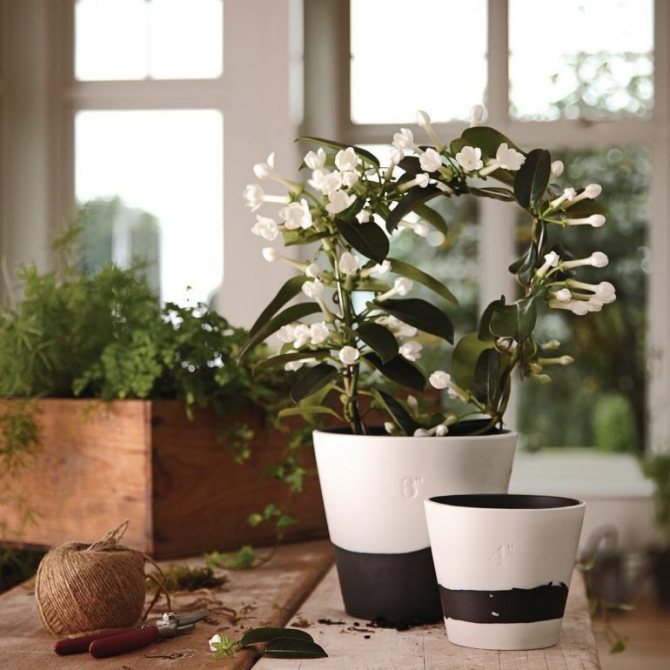
Stefanotis photo in the interior
Stefanotis is a contradictory plant. It is believed that if a flower is placed in the house where a girl lives, she will never marry... At the same time, many brides, going down the aisle, decorate their hair with Stephanotis and include it in their elegant bouquet. Relieves internal stress, improves the atmosphere in the house, bringing peace and harmony to it. A fragrant flower evokes positive emotions, makes introverted people more open.
Reproduction.
At home, Stefanotis can only be propagated vegetatively, that is, by cuttings, so I will not describe the seed method of reproduction. Cuttings must be taken semi-lignified, with 2 internodes. The roots are formed at the internode itself, so the cut is made 1-2 cm lower. The cuttings are treated with a root formation stimulant (root, succinic acid, etc.) and planted in a mixture of peat and sand (1: 1), or in a shop soil with perlite. Then the future stephanotis must be covered with foil or glass to maintain high humidity. It is very important to observe the temperature regime during rooting, it should not fall below 25ºC. At lower temperatures, cuttings can rot. After new shoots begin to appear, you can pinch the top for branching and gradually accustom to the air of the room.
How is it used?
Stefanotis is very beautiful during the flowering period. Florists often install an oval or ring support for it. The support entwined with a flowering plant resembles an elegant wreath. In spacious greenhouses, you can stretch a wire along which the plant will actively curl.
In some countries, stephanotis flowers are considered a mandatory attribute of the bride's attire. They are inserted into the hair, decorate a dress or make a bridal bouquet. It is believed that this plant gives happiness and love in marriage, and is also a symbol of a reliable relationship between spouses.
Content issues.
Stefanotis can be damaged by aphids, scale insects and spider mites. Well tolerates the use of insecticides. With a sharp hypothermia, leaves may crumble. Leaves can turn yellow and fall off as well with a lack of nutrients in the soil or lack of light.
16 Aug
Stefanotis or Madagascar Jasmine is a beautiful indoor flower for decorating any modern interiors in homes, apartments, offices and shopping centers.
- Madagascar jasmine or stephanotis flowers are a flowering genus of perennial evergreen vines.
- It belongs to the Kurtov family and is one of the most beautiful.
- At the moment, about 12-15 plant species are known.
- Since the description in 1806, almost everything has been used in culture when it comes to gardens of tropical and subtropical zones.
In Russia, indoor flowers Stephanotis are grown as a home culture and only two species: Stephanotis Frooribunda and Variegatny (Abundant flowering). In the photos in this issue, we will see how beautiful the liana is at home and in its natural habitat. The rules for planting, reproduction and organization of care at home described in the article will allow you to create the most suitable conditions for the culture. As a result, the liana of Madagascar jasmine will grow large and beautiful.
Look at the photo of Stephanotis, illustrating all its decorative qualities and choose a suitable species for your future breeding:
Madagascar jasmine stephanotis allows you to effectively decorate any room. Possesses exquisite beauty and splendid aroma during flowering.
Why problems arise and how to solve them
The most common pests for stephanotis are spider mites, mealybugs, greenhouse aphids and scale insects.
Table: Stephanotis pests and control
| Pest | Signs of plant damage | Preparations for processing plants | Pest control measures |
| Spider mite | The leaves are drooping, on the lower part of them there is an airy web | Insecticide treatment:
| For emergency assistance, you need to wash the plant in the shower and then treat it with drugs. |
| Mealybug | White waxy coating on stems, leaves, buds and flowers | The use of systemic drugs (insecticides):
| Alcohol treatment, treatment with water-oil emulsion, replacement of the top layer of soil. Treatment with drugs. |
| Shields | The stems are covered with brown tubercles | ||
| Greenhouse aphid | Deformation of leaves and buds | Insecticide treatment:
| All plants in the house should be treated with drugs, since aphids move easily. |
If any mistakes are made when caring for Stephanotis, this will immediately affect the condition of the plant, and it will let you know about it.
Table: buds fall, leaves turn yellow - the consequences of mistakes in the care of Stephanotis
| Signs of poor plant health | Reason for poor condition | What to do | How can you help a plant |
| With full growth, the plant does not bloom | Liana is located on the northern windowsill or in the back of the room | Move to the east or south windowsill | Give more light and feeding |
| Improper care in the autumn-winter period: inadequate rest | Provide complete rest of the plant in the autumn-winter period | Observe the temperature regime and frequency of watering | |
| Pot too spacious | Transplant into a smaller pot | Allow the roots to completely braid the earthy ball | |
| The plant sheds buds | Insufficient lighting | Provide adequate lighting | Give more light to the plant |
| Rotten roots | Check the condition of the roots and remove rotten roots | Observe the watering regime | |
| Leaves turn yellow and fall | Wrong, uneven watering | Provide uniform watering, without waterlogging or overdrying the soil | Maintain the desired level of soil moisture |
| Severe spider mite infestation (spider webs on the underside of leaves) | Insecticide treatment:
| Wash the plant under a warm shower and then treat with preparations | |
| Too small (small) leaves grow | High room temperature | Adjust the temperature | Do not place the vine close to radiators |
| Lack of nutrients in the soil | Transplant a vine or establish a feeding regime | Transplant and feed the plant in time |
Description of the plant jasmine stephanotis (with photo)
Beginning the description, it is worth noting that in the wild, the tropical beauty has spread widely across the islands of the Indian Ocean and the Malaysian archipelago. In India, Japan, Vietnam and China, the perennial Madagascar jasmine is used as a garden plant. The homeland of the stephanotis plant is considered to be the island of Madagascar. Flexible lashes, which branch well and form a large plant up to 6 meters in length, allow you to form various unusual compositions. On the liana, oval leaves with a leathery bright green base are located opposite. In length, the whole-edged leaf plate reaches 5-8 cm with a width of 4-5 cm. The base of the leaves at the petiole is oval, and the tip is pointed.
Check out jasmine stephanotis in a photo showing the splendor of the creeper in bloom:
The liana is especially picturesque during its flowering. During this period, buds of a wax texture are formed, similar to a crown of small petals "ears", fused into a tubular corolla. Flowers are always snow-white with a waxy texture. They consist of 5 petals and look like stars. The staminate tube reaches up to 4 cm in length and up to 5 cm in diameter with petals.
There are varieties of Stephanotis with flowers of a pale yellow, cream or greenish hue, but more often you can see exactly white buds or with an almost imperceptible purple tint. Fragrant crowns with ears are collected in loose umbellate inflorescences of 6-8 pieces. Wild specimens can bloom uninterruptedly for 10-11 months. The flowering of stephanotis at home can be seen only from the beginning of spring to the end of summer, especially in the middle lane. This is due to insufficient lighting and heat.
In the wild and in gardens, the fruit is set immediately after flowering. They are seed pods, similar to fruits (large plums or avocados), but they are not edible. In its natural environment, Stephanotis reproduces rapidly naturally, when the fruit cracks and scatters the seeds with parachutes, like our dandelions. The capsule can ripen throughout the year. Indoor specimens also tend to bear fruit, but most often they give sterile seeds that are not intended for further reproduction.
Botanical description
Despite the external similarity with the hoya, the perennial shrub belongs to another subfamily of the Lastovnevy family of the Kutrovy family and does not belong to succulents. For the first time, an exotic liana was found in the penumbra of the forest edges of Madagascar and the Malay Islands and was described at the beginning of the 19th century. The length of an evergreen liana in nature reaches 6 m, but at home, whips grow on average up to 2 m. Young elastic stems are elastic, with age they are prone to lignification.On short petioles, there are hard dark green ellipsoidal lacquer sheets with pointed ends in pairs.
Did you know? At night, jasmine smells more fragrant than during the day, since when the air temperature drops, the buds open completely.
.
The central vein at the fold of the glossy plate is pronounced. The leaves are up to 5 cm wide and 9 cm long. With proper care, they can reach the size of a human palm. If the stems and leaves are damaged, sap is released, irritating the skin and mucous membranes, therefore it is recommended to wear gloves when handling the plant.
The flower resembles a crown with inverted serrated petals. Five-petal flowers of milky white color with cream and lilac variations are collected in corymbose loose clusters. Corolla 5 cm in size has up to 7 buds, the diameter of which is 2.5 cm. Wave-like flowering lasts up to 10 months in nature, in room conditions it is limited to the period from May to October. In May and June, the largest number of flowers bloom with a delicate, sweet aroma. Another wave of budding is possible with proper care from October to December.
After pollination and wilting of the flower, an oval, capsule-like, inedible berry fruit is formed, when ripe it releases small pubescent seeds, similar to the seed of dandelions, which are carried by the wind in a similar way. At home, pollination is possible without a partner, but fruit ovary rarely occurs. The root system is well developed and tightly wrapped around the soil in the container.
Important! The intense scent of Madagascar jasmine is similar to a lily. Avoid placing the flower in the children's room and bedroom if there are signs of allergies or intolerances.
In the natural habitat, the decorative qualities of the cultivated Stephanotis floribunda are used to create hedges, since the plant is prone to branching and gives a large amount of basal growth. The flower is also popular in cut: flowers that do not fade for a long time, similar to stars, have become an integral part of bouquets for brides and an elegant decoration for a wedding dress.


Stefanotis floribunda and profuse flowering
At home, indoor stephanotis floribunda and abundant flowering take root well. This is a large, fast-growing liana with whips up to 6 meters in length. A distinctive feature is that this species produces many young shoots in one growing season, even without pruning. And the flowers of the plant appear only on fresh sprouts. This gives the abundant flowering Stephanotis the ability to form many snow-white buds. All plant varieties have white buds.
In the photo, stephanotis floribunda and profusely flowering ones are presented in a wide variety of variants for the formation of vines:
Species diversity and variety for the home
There are only 16 species (according to some sources, only 12) of stephanotis. The table will help you find out about the features of the most popular varieties.
Table - Varieties of stephanotis and their features
| Variety | Features of the |
| Floribunda / abundantly flowering | Snow-white flowers-stars 5-6 cm in diameter |
| Floribunda variegata | On the leaf plate, spots and stripes of yellow, light green, white shades |
| Thorsii | Delicate lilac inflorescences |
| Akuminata | Cream flowers |
| Grandiflora | Large inflorescences: one has up to 30 flowers |
The only variety adapted for indoor cultivation is Stephanotis profusely. Although Liana needs special conditions, she may well adapt to the windowsill. Ideal if there is an opportunity to grow Madagascar jasmine in a conservatory or greenhouse.
Beautiful star flowers of the abundantly flowering variety are often used to create a bride's bouquet: a composition with delicate inflorescences looks stylish and touching. By the way, a place for "stars" was also found in the history of Princess Diana's bouquet: a luxurious cascade of white fragrant flowers almost touched the ground.
Reproduction of Stephanotis by cuttings at home
At home, flower growers use several methods to acquire a new plant. One of them, the simplest, is to buy a vine in a store as an adult. Here the difficulty may arise that if the plant has been adapted to the greenhouse, then it will not be easy to organize proper care in indoor conditions. Another way is to purchase rooted cuttings. Their price starts from 300 rubles, which is two times cheaper than the most unpretentious adult plant.
An even more budgetary option is seed reproduction, their cost starts from 100 rubles. But, this method is suitable only for flower growers with extensive experience and an inexhaustible supply of patience. That is why, the easiest way is to propagate Stephanotis by cuttings, which can be purchased in the store or cut from an adult liana.
For cutting and reproduction of Stephanotis, young semi-woody shoots are taken, a little over 1 year old. You need to cut healthy parts from early spring to mid-summer. You can take flowering shoots, they also take root easily. Before rooting, the cuttings are treated with a root former and placed in wet clean sand at an angle. The permissible depth is no more than 2 cm. The planting is covered with polyethylene or glass from above and placed in a greenhouse with lower heating. For rapid root formation, phytoharmonics can be used. Rooting under all conditions will occur within 2-5 weeks.
After the cuttings of Stephanotis take root, they can be transplanted with an earthen clod into narrow, shallow pots with nutritious heavy soil. Slightly acidic soils are suitable for growing perennial vines. As a nutrient mixture, you can use the following composition: turf (taken from loamy soils), leafy soil, peat and coarse sand with the addition of compost. Florists do not recommend using alkaline soils, since Stephanotis does not plant buds on them.
Plant characteristics and species
Stephanotis grows up to 6 m long. The plant is a liana with wrapped petals and white flowers. However, stephanotis also come across with cream-colored inflorescences. One vine can have up to 7 buds. The flowering period usually begins in May and ends in July. The dark green oval leaves are capable of growing the size of a human palm.
A variety of abundantly flowering species is Stephanotis floribunda variegata. A distinctive feature of this variety is the color of the leaves, which have light green, whitish and yellow spots.
Important! For normal growth, Stephanotis requires an abundance of space. It is not recommended to start this plant in a small apartment. There it will not be able to develop and bloom. You can, of course, create suitable conditions artificially, but it will not come cheap. But in a large country house, and even in the presence of a winter garden, this plant is simply necessary.
Under favorable conditions, you can even wait for the appearance of fruits in Stephanotis, only they cannot be eaten. From them you can get seeds for subsequent cultivation. The fruit is pear-shaped and reaches 10 cm in length. It will take him several months to mature. When ripe, the fruit is dark brown in color.
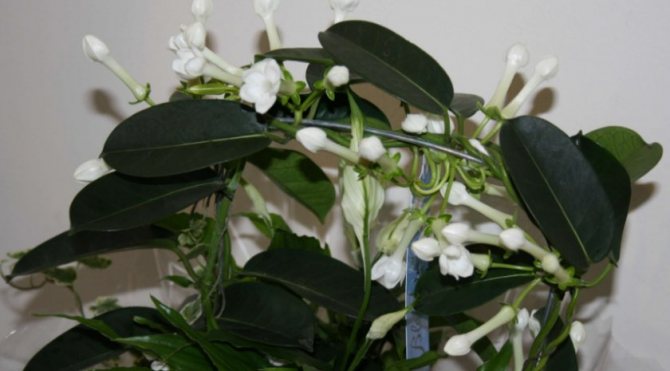

Stefanotis indoor
Home care stephanotis
When grown at home, stephanotis can cause many problems, as it is a very finicky plant. It will not be difficult for an experienced grower to organize the care of this plant with knowledge of some of the nuances.
To begin with, before organizing the care of Stephanotis, you need to know one of the important points - this is the choice of the location of the plant. The fact is that the juice of a perennial vine is very pungent and poisonous. It burns and irritates the skin and can be toxic if swallowed. Therefore, the vine is best placed away from pets and children. Wear gloves when handling it, especially when pruning in the spring. The juice leaves severe irritation on sensitive skin.
Stefanotis loves bright sunlight. Despite the fact that in his homeland he is accustomed to direct sunlight, at home it is better to shade him from them. Southeast and southwest windows are suitable for placement both in summer and in winter. If you put stephanotis indoor flowers on windowsills with a southern orientation, then shade the plant from direct sunlight. When placed in the interior and in the north, make up for the lack of lighting with phytolamps. Bright diffused light is the basis for the growth and development of perennial vines. In the winter season, provide additional hours of daylight hours for Stephanotis at home (optimally + 2 ... 4).
An important point is that as soon as the first buds appear on the stephanotis, you cannot change its position and turn it. For reasons unknown, even the slightest movement affects the bud setting. An excess of light leads to the fact that the stephanotis flower stops its growth, and its lack provokes the fall of flowers and lethargy of the leaves.
How to propagate jasmine
Stephanotis is propagated vegetatively using stem cuttings and sowing with seeds. The best seasons for breeding are spring and summer.
Seeds
At home, this is difficult to implement, since the fruits do not ripen to the end. Ordering seeds is also not worth it - they do not withstand long transportation and do not give germination. But if your plant has successfully passed all stages of development and has borne a ripe fruit with seeds, you can be patient to try to get seedlings.
Did you know? Jasmine tea is made from the fragrant flowers of sambac, a similar variety of indoor jasmine.
For this:
- Leave the freshly harvested seeds to dry for 2 days.
- Then soak them in warm water for 2 days, adding a few grains of "Epin" and potassium permanganate.
- Prepare and sterilize the soil for seedlings - mix equal parts peat with perlite or sand, steam or heat in the microwave for 1–2 minutes, transfer to a container for seedlings.
- Lay out the seeds, pressing slightly into the soil.
- To create greenhouse conditions with an ideally humid microclimate without air circulation, cover the future seedlings with glass, transparent plastic, or place in a transparent bag.
- Place the seedlings in a warm, bright place (+ 22 ... + 25 ° С) without direct sunlight.
- Remove the shelter periodically to ventilate and moisturize, wipe the accumulated condensation on the cover.
- After 3-4 weeks, the first shoots will appear, after which the container can be left uncovered.
- When the first pair of leaf plates appears, cut out the seedlings in 2-3 pieces. in small pots with soil mixture for an adult plant.
- Feed the plants after 2 weeks with a weak solution of nitrogen fertilizers, so you get a lush green mass.
- With a daylight duration of less than 14 hours, young bushes will have to be supplemented.


Cuttings
The reliability of the vegetative reproduction method seduces with its simplicity.
Important! Bottom heating in a makeshift greenhouse will increase the chance of rooting.
You can do it this way:
- Cut at an angle the apical cuttings of last year's branches up to 10 cm long or use semi-lignified ones after pruning, with 1-2 internodes.
- Leave one pair of upper leaves, remove the lower ones, dip in a rooting stimulant.
- To speed up the process, cut off the top half of the sheet, sprinkling the cuts with charcoal.
- Prepare loose, moist soil from a portion of the standard plant soil mixture, to which you need to add an equal portion of sand or perlite. Place the stalk at an angle, digging in to a depth of 1.5 cm.
- Create a greenhouse and place in a warm place (+ 25 ... + 30 ° C) with an abundance of ambient light, ventilate the cuttings daily and maintain humidity.
- Within 1.5 months. rooting will occur, which will be indicated by the appearance of new greenery on the shoot.
- Plant them permanently in the soil for an adult plant and form as they grow. When you reach 50 cm, cut the branches one-third for branching.


Temperature, watering and humidification
In summer, the optimal temperature regime for Madagascar jasmine is + 22 ... 23 degrees Celsius. If the temperature is higher, then this provokes a rapid evaporation of moisture. In general, as far as heat is concerned, here Stephanotis does not manifest itself as a finicky plant. In winter, he feels comfortable at temperatures from 11 to 17 degrees. Wintering for a plant is a prerequisite, without it, it does not lay buds. The only thing worth considering is that the perennial does not like sudden changes, so it is not recommended to leave it overnight in the garden or on the balcony. The same goes for gusts of cold winds and drafts, which should be avoided when ventilating, especially during the winter season.
In order to form various unusual compositions from stephanotis, supports for vines are used. These can be purchased at flower shops. Only young growth is tied up. Lignified shoots do not give the desired result. As for pruning, every spring they cut off half the growth of the vines. Pinch the shoots several times per season. If you do this in the summer, then Stephanotis will bloom much longer. Be sure to remove withering buds, as if you do not do this, the plant will begin to set fruit and bloom less abundantly.
An important part of caring for stephanotis at home is watering and humidifying the air. The tropical beauty prefers heavy wet soils. This requires abundant, but not frequent watering as the earthy coma dries up. Drought is detrimental to the root system and the entire plant. For watering and spraying, use only thawed moisture at room temperature. In winter, water treatments are reduced to avoid stagnation and waterlogging. It is necessary to spray Stephanotis regularly several times a day, especially in winter when the central heating is turned on and in summer. Artificial hydration is recommended.
Florist reviews
Now I have transplanted my "jasmine" in 8 months for the second time, since the roots were almost all at the top. It was very cramped for him. For the umpteenth time I come across a problem, according to all the rules, it is necessary to transplant plants into a pot not much larger than before. But, apparently, in me they grow by leaps and bounds and grow out of it very quickly. Some even have to be replanted earlier than a year later. My friend went through the second transplant calmly, since I did not break the earthen lump and simply transferred the plant into another pot.
LanaSvet83
I re-read a huge amount of information about him on the Internet, I read that he does not like to be twisted and touched during the flowering period. What needs to be transplanted into a larger pot, but I'm still afraid. Since he began to grow and bloom very quickly. Due to this, I water it often enough so that the soil is not dry. The flower is in our room by the window. We have a sunny side - from morning until lunchtime there is a lot of sun. But, apparently, he likes it there)
Harmful_Angel
Stephanotis did not please me with flowering at home for long. A few days later all the flowers were discarded. I bought it in the fall and could not judge what would happen next, since a period of dormancy begins. It did not take long to wait, soon a process appeared from the axils of the leaves.It should be noted that the flower is curly and you need to worry about support. The stems can stretch very quickly 5 cm a day. To be honest, I did not know what to do. There is very little literature and information on this flower, and there are very few details. In flower shops, a lash is tied to a thread, and then wrapped around a stubborn wire. While I was thinking about where to attach the new lashes, I ended up buying a bamboo lattice, but the first lash turned yellow and dried up, but new ones began to appear just as quickly. I only had time to tie the threads and wrap the bamboo arc. But the trouble is with flowering. For 2.5 years that he lives with me, he bloomed once - 3 flowers and the next day he discarded. By the way, it blooms for a very long time. From the moment the buds appear to flowering, 1-2 months pass.
KIrra
Stephanotis transplant and feeding
The first stephanotis transplant is required immediately after purchase. This is done by transshipment so as not to damage the root system. As a container, take a pot a couple of cm wider. 1/5 of the planter should be the drainage layer. Remember the drain holes in the bottom! Some growers do not transplant adult plants at all, replenishing nutrient reserves with the help of dressings. In the first years of life, a transplant may be required for a plant, since if the roots become cramped (and in Floribunda, young root shoots are formed very quickly), the leaves of Stephanotis turn yellow.
Complex fertilizers are used as top dressings, provided that the plant has not been transplanted for a long time. If the transplant was in this season, then there will be enough substances for the vines that are in the nutrient substrate. 2-3 hours before applying liquid fertilizers (for example, a solution of cow dung or other organic matter), the perennial is watered abundantly.
Care errors
The main difficulty in growing a tropical guest is that he does not forgive mistakes in care. If you deviate even a little from the rules, Madagascar jasmine will begin to wither before our eyes. Errors lead to the fact that Stephanotis leaves turn yellow and fall off, the vine refuses to grow and bloom. Do not worry: if you immediately respond to the signals of dissatisfaction, then the problem will be solved quickly and easily - you just need to optimize the care. The main thing is to understand where the mistake was made.
Slowdown in growth and the appearance of "problem" leaves
Stefanotis leaves are of no less decorative value than flowers. The sheet blanket loses its beauty if the “pet” is not satisfied with the quality of care that surrounds him. Gaps in care can also come back to haunt the stunted growth of vines. Why “problem” leaves appear, and Madagascar jasmine suddenly stops growing, you can find out from the table.
Table - Problems in growing Stephanotis and their causes
| Problem | Cause |
| Growth slows down | Lack of nutrients |
| Black dots appear on the leaves | - Waterlogging; - excess nitrogen in the soil |
| Leaves darken and fall | Temperature too low |
| The coverlet turns yellow | - Too high temperature; - dry air; - weak soil moisture; - hard water; - little light; - root damage |
| Leaves fall off abruptly and massively | - Sudden drop in temperature; - the flowerpot stood in a draft |
| Leaf veins turn white | - Lack of nutrients; Too much bright light |
It is no longer possible for problem leaves to regain their former beauty. They are removed. If you optimize the care, the plant will grow, and new beautiful leaves will appear in place of the old ones very quickly.
No flowering and stimulation method
In an apartment, the plant blooms annually for four months. Flowering begins in June. However, it happens that the grower is waiting for the appearance of white stars, but they are not all ... This is due to improper care. Work on the mistakes and the plant will delight you with its fragrant flowers. Look for the flowering problem and its causes in the table.
Table - Problems with flowering stephanotis and provoking factors
| Problem | Why did it arise |
| Lack of flowering | - Warm wintering; - temperature drops; - not enough light; - lack of cropping; - excess nitrogen in the soil |
| Weak bloom | - Incorrect cropping; - high wintering temperature; - dry air; - some of the buds got water |
| Falling buds | - Draft; - turns / rearrangement of the flowerpot during budding; - sharp temperature drops; - insufficient moisture |
Stefanotis will bloom annually, if you protect it from "stress" in the form of temperature changes and drafts, do not disturb during the budding period, send it to rest, cut it off with the arrival of spring. For long-lasting flowering, use the advice of experienced flower growers: pinch young shoots in the summer, leaving eight pairs of leaves on one stem.
Flowering pleases only adult specimens: those that are already three to four years old. If the pet has not reached the age of three, then do not reproach yourself for the wrong care: the lack of flowering is due to the youth of the plant. Here it remains to cherish the pet and wait.
What to do if Stephanotis leaves turn yellow and fall
Before you do anything, you need to find out that liana is often attacked, especially in the summer, by aphids, spider mites and mealybugs. The sweet scent of the blossoming flowers attracts the scale insect. They get rid of pests with special preparations - insecticides. The leaves of stephanotis may indicate that the plant has some kind of problem, for example:
- if the leaves of Stephanotis turn yellow, if there is not enough lighting or if the root system is damaged;
- the leaves become dull and lethargic - excessive watering (in this case, you need to remove the plant from the pot, examine the root system for rot, remove the affected areas, replace the soil and transplant);
- if Stephanotis leaves turn yellow and fall off, then you need to check the plant for chlorosis and the presence of pests.
Stefanotis does not bloom if:
- not enough microelements (soil replacement or feeding is required once a week throughout the vegetative period. When replenishing nutrient reserves, focus on fertilizers with a high content of potassium salts and superphosphate);
- it is affected by a temperature drop or a draft - the plant will take time to recuperate. Usually, it takes at least a season.
Categories: / / by
Stefanotis from the Lastovnev family are semi-handicraft vines common on the island of Madagascar, as well as in Japan, China and Malaysia. Under indoor conditions, it is possible to grow only Stephanotis floribunda (profusely flowering), or, as it is also called, Madagascar jasmine.
Stephanotis flower: care
It will take time, attention and effort from you to grow indoor stephanotis. A poorly lit and narrow window sill does not suit him: a fast-growing and abundantly branching vine requires space and enough light. But keep in mind that direct sunlight can leave burns on the leaves, so it is advisable to shade the flower at midday.
In addition, this plant needs a long day of light, so you will need to arrange additional lighting during the winter season. In summer, the temperature regime for the stephanotis flower should be such that the plant does not overheat, and in winter the flower will be comfortable in cool conditions at a temperature of about 15 degrees. After a cool winter, Stephanotis blooms longer and more abundantly.
Caring for a flower involves regular watering with settled water. In summer, watered every other day, and in winter, it is enough to water once a week. Stephanotis loves high air humidity, so in warm weather often spray the leaves of the plant with soft water or wipe them with a damp sponge, being careful not to get on the flowers or buds of the plant.In winter, when the heating devices are working, it is recommended to keep the flower pot on a pallet with moss or wet pebbles.
Stephanotis needs to apply organic and mineral fertilizers twice a month, from March to August. Start feeding when you notice the first signs of active growth and then if the plant has not been transplanted for a long time, since fresh soil contains a sufficient amount of all macro- and microelements. On the eve and during flowering, potash fertilizers are preferred when feeding. In autumn and winter, the stephanotis flower does not need feeding.
Try not to rearrange or even turn blooming stephanotis, as it is very delicate and will shed flowers and buds.
Stephanotis: propagation by cuttings
This plant is considered difficult to root. Seeds rarely ripen and germinate poorly. For the appearance of roots in cuttings, special stimulants of root formation are used.
Cuttings should be cut from semi-lignified healthy shoots with 2-3 leaves. Cut just below the knot about 2 cm and plant in soil mixed in half with sand. Cover the planted cuttings with glass or plastic. It is very important to monitor the temperature: the soil must be warm enough (up to 25 degrees). Roots are formed in half a month or a little later. When the cuttings produce shoots and leaves, place them in a bright, cool place. After planting a young plant, pinch the top of the shoot, then the vine will begin to branch.
Stefonotis blooming
Its second name is Madagascar jasmine, it is climbing shrubs with powerful climbing stems up to 5 m long.The leaves are elliptical, opposite, 10 cm long and 5 cm wide, with a short tip at the top, glossy, dark green, dense, whole-cut, with a light vein in the center of the leaf blade. Waxy flowers are collected in a false umbrella of 5-7 pieces, white, very fragrant, about 4 cm long and 5 cm wide.
The plant is widely used for decorating winter gardens and interiors.
Why does stephanotis turn yellow
Before deciding what to do in such a situation, you should first find out the cause of this phenomenon. If the leaves of the flower begin to turn yellow, then the main reason is your oversight or violation of the rules of care. Most likely, you watered the plant with water containing lime, or keep the light-loving Stephanotis in a poorly lit place. It happens that in this way the flower reacts to the transplant or it lacks fertilizer. Be attentive to the needs of your flower and follow the rules for plant care.
By the way, some of the leaves turn yellow and fall off with the arrival of winter, and this is normal. Stefanotis does not react well to the fact that the day is getting shorter, he does not have enough light. The flower can lose up to 50% of its foliage, but in the spring it will come out of dormancy and new leaves will appear from the axillary points.
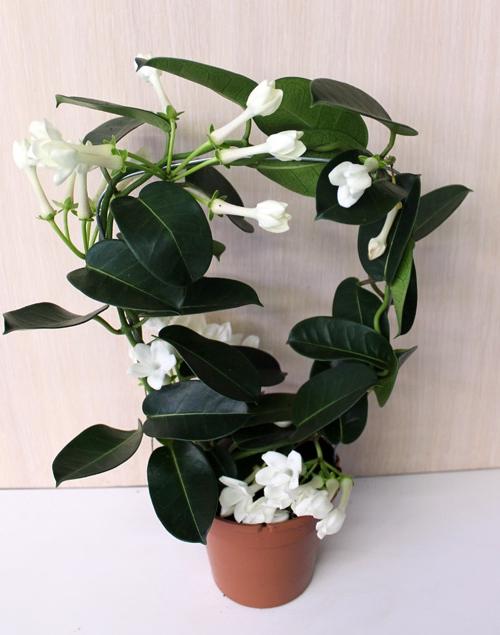

Stephanotis: signs and superstitions
It is believed that this flower, like ivy, is a muzhegon. It is assumed that if Stephanotis appears at home, the wife risks being left without her husband.
There is also another sign. Since Stephanotis is extremely capricious, whimsical and gentle, it blooms very rarely. But if the flower has bloomed, then this omen is considered a good omen that the girl living in the house will soon get married and be happily married.
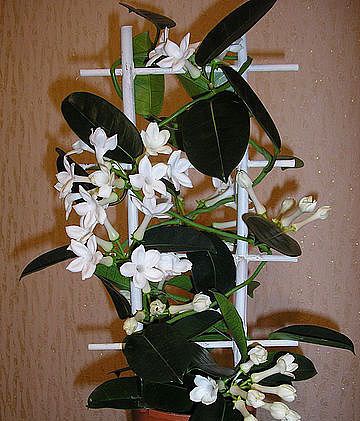

Overseas handsome stephanotis
firmly won its place in the sun on the windowsills of many gardeners.
His snow-white flowers
against the background of dense dark greenery give the house charm and comfort.
Stefanotis demands to himself a lot of attention and patience
.
However, with proper care, it reveals itself in all its glory
, exuding a pleasant scent around him.
Diseases and pests
With careful care, the plant grows healthy, but sometimes diseases and pests fall on the stephanotis. This is noticeable by external symptoms that spoil the appearance of the plant:
- petals and buds crumble - little light, droplets of water hit when spraying, drying out the soil, moving the pot during flowering (rearrange to a bright place; gently water and spray; water abundantly; do not change the position of the pot during flowering);
- leaves droop and darken - the plant is cold (rearrange to a warm place);
- growing slowly - lack of nutrients (feed);
- leaves stephanotis turn yellow - watering with hard water, little light, cold to the plant, stagnation of moisture in the pot (to defend water for irrigation, add 0.2 g of citric acid or 3-5 drops of lemon juice in 0.5 liters of water; rearrange to a warm, bright place; make a few drainage plants at the bottom of the pot);
- flower buds curl - insufficient watering (water abundantly, then correct watering);
- yellow—brown streaks on the leaves - an excess of bright light (shade the midday rays or rearrange to a less illuminated place);
- pale spots on the leaves - little light (rearrange to a brighter place);
Many florists care why Stephanotis does not bloom... This can be due to various reasons:
- improperly organized rest period - in winter it was warm, a lot of light, the flower was fed and watered abundantly or often;
- flowers and buds are dropped - during flowering, stephanotis was rearranged, turned to the light by the other side;
- poor flowering - little light or nutrients;
- transplanting during flowering - double stress for the plant;
- spacious pot - for flowering, the roots must completely encircle a clod of earth.
Pests include aphids, spider mites, scale insects, mealybugs. The affected plant is treated with an insecticide.
What do we know about Stephanotis?
Evergreen herbaceous vine
Stephanotis came to us from the distant island of Madagascar. The plant looks very unusual due to its curly long stems with dark green glossy leaves.
Especially impressive are those similar to stars flowers
stephanotisa - white clusters of blossoming crowns of five delicate petals on graceful legs. Due to its delicate aroma, the flower is sometimes called exotic.
Madagascar jasmine
.
Stephanotis flowers are common in
wedding bouquet
whose touching beauty gently complements the white dress of the bride. The curly stems of the plant branch lush and densely and, with proper care, grow long
up to 6 meters
... With the help of lattices and special supports, stephanotis is used to decorate walls, windows and winter gardens.
In nature, 12 types of flowers are known, but only Stefanotis profusely flowering Floribunda
.
In nature, the plant blooms most of the year, and indoors - from spring to October.
Video: a memo for loving owners of stephanotis
Stefanotis is a beautiful tropical plant that is used at home to decorate large rooms and halls. Compliance with the requirements for caring for the plant, which are important for the plant, will make it possible to admire the juicy, shiny foliage and fragrant flowers of the climbing liana all year round. If you want to make Stephanotis bloom, do not forget to provide him with winter peace, do not repot it again, cut and feed in spring, but make sure that there is no excess nitrogen in the soil and fertilizer. This vine has long creeping stems, and with the correct formation of their growth, various green compositions are created with the help of supports, from compact to filling the entire space of the room with the luxury of a tropical forest.
Care features
Stafanotis at home requires strict adherence to the rules of care, patience and care. It is important to remember that the sap of the plant is quite caustic and can be irritating
... Florists with sensitive skin are advised to take care of Stephanotis in
rubber gloves
.
Lighting and location selection


Southerner Stephanotis loves light and sun, but not direct sunlight, which can cause burns
on its leaves.
In the hot season, it is advisable to keep the flower on the west or east window. If he settles on the southern windowsill, from the active sun of his will need to shade
.
A heat-loving plant does not like overheating
... In summer for him, the temperature should not exceed
23 ° C
, and in winter it loves light coolness -
about 15 ° C
.
With a lack of lighting, Madagascar jasmine stops blooming.
But if in winter
arrange for him to light up
, Stephanotis will be able to delight its owners with the exquisite beauty of delicate flowers all year round.
Stefanotis does not tolerate cold, drafts and temperature changes
.
You need to keep it on a window that is not used for ventilation, especially in winter. During the appearance of the ovary, the flower should not be rearranged from place to place and even turned from side to side. to avoid cessation of flowering
.
Air humidity and watering
Stefanotis comes from the humid subtropics and therefore prefers high humidity
... You need to place the plant in the winter as far away from the batteries as possible and try to provide it with
artificial humidification
.
You can put containers with water next to it or humidify the air regularly
around the plant from the sprayer.
Madagascar jasmine loves
daily abundant hydration in the warm season. You need to spray it with clean, slightly warm water, trying not to fall on delicate inflorescences.
In winter, a flower is desirable moisturize with care
and not so abundantly. From spring to autumn, stephanotis is watered with soft water at room temperature
once every 2 days
.
To provide a flower
constant humidity in summer, you should put the pot with the plant in a container with gravel and water poured into it. All that remains is to ensure that the gravel is always wet and the bottom of the pot is dry.
In winter time
the flower is watered
once every 7 days
.
Soil and transplant
The capricious Stephanotis prefers a slightly acidic soil with a complex composition. For normal plant growth
make the following mixture: peat or humus, sand, clay and deciduous soil in
ratio 3: 2: 1: 1
.
Alkaline composition of the earth may interfere with flowering
Madagascar jasmine.
Stephanotis is transplanted only when necessary.
Young the plant can be transplanted
every year at the end of winter until bud ovaries appear, adult - once every two to three years.
Flower transplant
is carried out as follows:
- Is selected heavy ceramic pot
1 cm larger than the old one - it should be noted that Stephanotis has a powerful root system. - It is important not to forget to put drainage on the bottom of the pot, so that there is no stagnation of water
. - Stephanotis is transplanted into a new pot by transshipment with an old clod of earth left, so that small roots do not get damaged or break off, otherwise the flower may wither
... If this does happen, you need to add root growth stimulants to the water for irrigation. Small roots will grow back quickly and
the plant will come to life
. - After transplanting, the plant follows water with care
, avoiding an excess of water in the roots. It is better to spray more often. - In the middle of summer, to prolong the abundant flowering, the shoots of Stephanotis need to be pinched, leaving 8 pairs of leaves on the stems
.
Vine formation
Stefanotis is attractive to many flower growers in that it can form the original shape of the plant
by doing the correct cropping.
It can grow as a compact bush or a long, branching vine that flanks a wall. The flower is cut in early spring
.
Damaged and weak shoots are removed first, and other stems can be cut to half the length. It is desirable to cut the main stem as less as possible
.
Strong pruning Stephanotis is afraid
so you need
do it with care
otherwise it may not recover.
Plant feeding
Feed stephanotis
desirable
only in the spring-summer period twice a month with fertilizers for flowering plants. In winter, it is better to give a flower
take a break from feeding
... In the spring, when the buds are formed,
choose fertilizers
with a low nitrogen content.
Transfer
Soil: which one to choose or do it yourself
The transplant is usually carried out once every two to three years, in the spring, by the method of careful transshipment... It is not worth disturbing the vine in vain, replant when the roots begin to peep out of the upper layer of the earth. At the same time, it is not recommended to significantly increase the capacity of the pot, so as not to delay flowering. Since Stephanotis prefers heavy soils, a mixture is prepared for transplanting in the ratio "peat: sand: clay: leaf earth = 3 parts: 2 parts: 1 part: 1 part".
At the same time, a layer of drainage material (expanded clay balls) with a thickness of at least 3-5 cm must be placed on the bottom of the pot. They can be purchased at any flower shop.
The soil should have a slightly acidic reaction, that is, a pH of 5.6 to 6.0. There will be a note on the pH level on the packaging of the prepared soil.
Take a pot that is massive enough so that the growing and gaining strength shoots of Stephanotis do not overturn it.
For planting stephanotis, you can also use purchased ready-made soils, such as:
- “Flower” soil (Nitrogen - 200 mg / l; acidity pH = 5–6) produced by JSC “Udmurttorf”;
- nutrient soil "Garden of Miracles" (Nitrogen - 200 mg / l; acidity pH = 5.5–6.5).
Other universal soils are also suitable. The main thing when buying ready-made soil is to familiarize yourself with its composition by the main elements (N, P, K - nitrogen, phosphorus, potassium, respectively), which should be printed on the packaging, and acidity (pH within 5-6).
Whenever possible, choose soil with less nitrogen than other components.
Support making
As already mentioned, stephanotis is a vine with a long creeping stem, capable of wrapping around various objects. Young shoots are flexible and lend themselves well to laying on a support. The laid shoots must be fixed on a support. Thanks to the shape and reliability of the support, a beautiful bush is formed, which, when blooming, will become a real decoration of the interior. The material for the support is wooden, metal or plastic structures of various configurations.
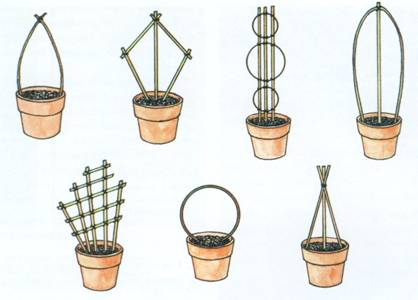

Choose support for the shoots of Stephanotis rigid and, if possible, not wooden
Since in the spring-summer period, frequent spraying of foliage with water is provided, wooden supports are the least practical and will quickly fail. The most popular are the supports in the form of a circle, on which the shoots of stephanotis are strengthened.
Photo gallery: options for weaving small and long shoots of a creeper on a support
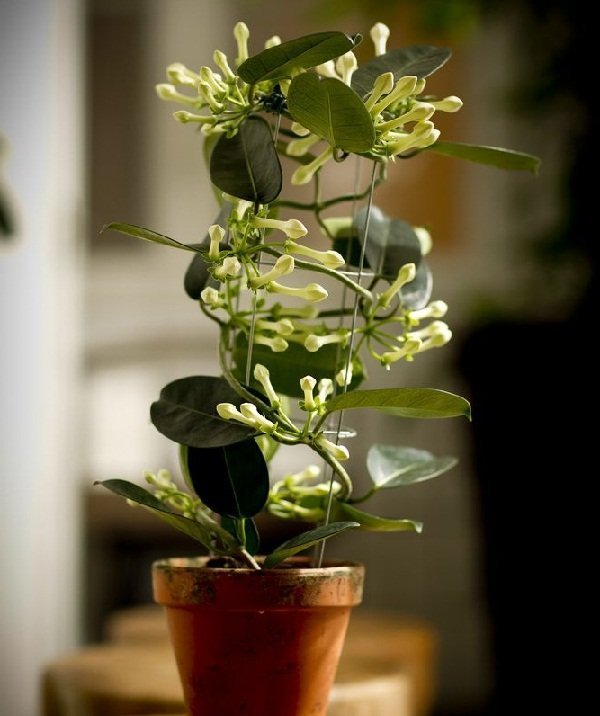

Spiral weaving of stefanotis stems looks great if the flower is still young
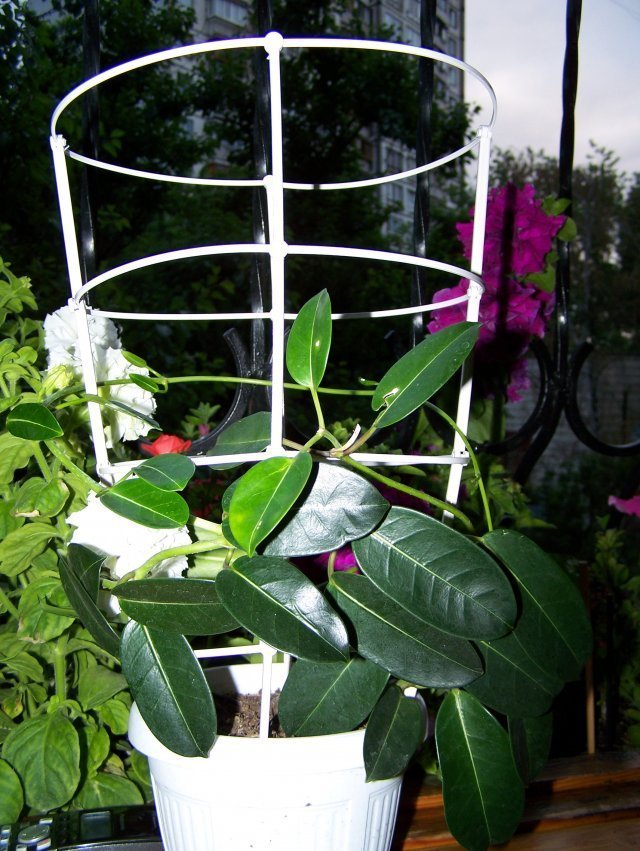

The weaving of stefanotis stems along a volumetric support is justified for an overgrown liana Stefanotis stems on a round support are a classic of the genre
Reproduction
Madagascar jasmine propagates cuttings
and
seeds
.
Home care plant seeds practically do not ripen
, therefore, the seed method of planting is not used.
Planting stephanotis with cuttings is best in early spring
.
The breeding order is as follows:
- It is necessary cut off shoots
that have one pair of leaves. You need to trim a little lower than these leaves. - Followed by plant shoots in the mixture
from sand and peat and keep them at a temperature
about 25 ° C
... After a month, the shoots should start up the first roots. - Then the plants need transplant into separate small pots
and keep them in a bright room at a temperature
16-18 ° C
. - Further once a year
seedlings need to be rolled over and pinched.
The main problems of Stephanotis:
- Leaves begin to turn yellow.
Reasons: lack of light or watering with hard water. - Rare bloom.
Reasons: lack of food, poor lighting.
As you can see, Stephanotis is successfully grown at home.A little work, patience and gentle care - and the plant will reward the diligent grower with juicy fresh green leaves
and the luxury of white
exquisite flowers with the finest aroma
.
For lovers of exotic indoor flowers, Stephanotis is well known as Madagascar jasmine. First of all, it's worth noting that they are not exactly the same thing. The name "stephanotis" means a separate species of plants from the Lastovnevye family. There are about 16 of them in total, and almost all of them grow in natural conditions. These are semi-shrub vines with evergreen leaves and beautiful flowering.
In indoor conditions, only one variety of vines is most often grown - floribunda or profusely flowering Stephanotis. This species is also called Madagascar jasmine for its characteristic aroma of flowers.
Thus, it is one of the varieties of Stephanotis, most adapted to indoor conditions.
What are the varieties of Stephanotis
The plant is distinguished by the color of flowers. A total of 16 species known to science are described that can be found in Cuba, Japan, South China, Indonesia, the countries of South Africa, but only Stephanotis floribunda and its variety Floribunda variegata with striped and spotted leaves are domesticated, smoothed at the end. These species, unlike the rest, have managed to adapt to indoor conditions after the warmth and humidity of tropical forests.
Check out the Grand Duke jasmine.
In addition to them, in nature are often found:
- Stephanotis Acuminata with a creamy shade of flowers;
- Stephanotis Grandiflora (Stephanotis Grandiflora) with a characteristic dense inflorescence, consisting of 30 large flowers, and greenery at the thin base of the bud;
- Stephanotis Thouarsii, whose purple flowers have a delicate pink throat.


What does Stephanotis Floribunda look like?
Stefanotis Madagascar, like other representatives of this species, grows in the shape of a liana - its strong shoots can reach a length of up to 5 meters. Wax leaves up to 9 cm long and up to 5 cm wide flaunt on the branches all year round. They are dark green in color, very dense in structure and slightly pointed at the tips. They are located oppositely on the shoot.
At the beginning of summer, beautiful inflorescences appear on the liana: there are five slightly wrapped petals on a thin tubular leg, and the flower itself resembles a white crown on the leg (sometimes there is a cream color in the color). The total length of the flower reaches 4 cm, they are collected in inflorescences up to 7 pieces in each. In natural conditions, Stephanotis blooms almost all year round, but indoors the flowering ends with the arrival of autumn.
The inflorescences stay on the branch for a long time, and even after cutting they do not fade for a long time. Thanks to this, they are used to create flower arrangements, in particular, wedding bouquets.
After the end of flowering, in place of the inflorescences, fruits similar to plums are formed. When they are fully ripe, they burst. Inside the fruit are seeds in the form of small parachutes. When they get into a nearby flowerpot, they germinate and form a new plant.
Description of culture
The Stefanotis represent the Lastovnevye family. These plants are climbing, they need support. In nature, they twine around trees. Flowers are native to the subtropics and tropics. In apartments, a variety of Stephanotis is most often grown - Madagascar jasmine. It is best suited for indoor living. Gardeners love this exotic for its unusual snow-white flowers. The peculiarity of the species is the abundance of buds. In each inflorescence, there can be from 4 to 7 pieces. During flowering, the apartment is filled with a pleasant aroma, similar to the smell of jasmine. It is because of this feature that this type of stephanotis got its name. Also, the plant can be called Stephanotis profusely.
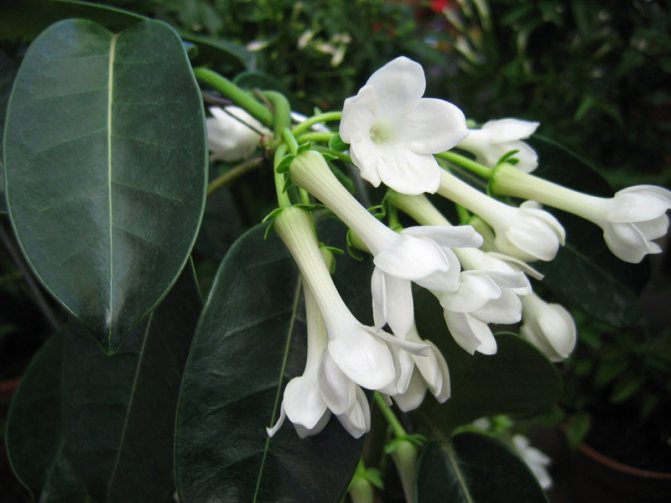

Madagascar jasmine
Flowering is usually long and lasts throughout the summer.By autumn, plum fruits appear on the crop. Seeds are located inside. They resemble parachute-like dandelion seeds and can migrate, that is, fly in different directions.
The stem of the culture is climbing. Jasmine liana wraps around any support. You can use the plant to decorate arched compositions. The leaves are large (about 8-10 cm), glossy, elongated with sharp tips. The color is dark emerald.
Important! The sap of the plant is pungent. If it gets on the skin, it causes mini-burns. Working with the plant is allowed only with gloves.
What does Madagascar jasmine love?
When growing stephanotis, you should pay attention to the following points:
- The flower loves good lighting. This is especially important in winter, when the daylight hours are shorter. At this time, it may be necessary to install additional lighting. In summer, the pot must be shaded so that direct rays do not fall on the plant, from which burns appear on the dark leaves.
- Jasmine needs to create a comfortable temperature: in summer it should not be higher than 25 degrees Celsius, and in winter the flower needs coolness (up to 15 degrees). This contributes to more lush flowering the next year.
- Watering should be regular, the soil should not be allowed to completely dry out. In addition, the leaves should be sprayed frequently in addition to maintain moisture. During the heating season, the flowerpot can be placed on a tray with pebbles.
- With the onset of spring (when growth processes are activated) and throughout the summer, jasmine should be fed twice a month with mineral preparations with a predominance of potassium. You can also use organics, but alternating fertilizers.
- Every year in March, it is necessary to cut the bush, and during the summer - to pinch the tops of the shoots. Jasmine Madagascar blooms only on new branches.
- To give the flower a beautiful look and prevent damage to long branches, vines, you need to install a support. It can be either an arch or stretched ropes. It is better to lay branches while they are young and not lignified, since then it is very difficult to do this.
Care
Vessel for Stephanotis
Experienced growers advise taking large containers. Exotic cultivation should be organized in a ceramic pot. It is such a capacity that a powerful plant can withstand. There must be drain holes at the bottom. Pebbles or expanded clay are placed on them.
The soil
Jasmine bush: care and cultivation in the garden
The soil that is ideal for a plant is a substrate of peat, sand, clay, and humus. The pH should be between 5.5-6.
Top dressing
The luxurious plant is responsive to fertilizers. It is recommended to feed it with mineral mixtures, in which potassium must prevail. Fertilizers with a large amount of nitrogen should not be applied, since nitrogen will give the plant strength to form greenery, but not flowers. It is permissible to feed stefanotis jasmine with special nutrient solutions for flowering ornamental plants.
Important! It is recommended to feed the jasmine shrub every 14-18 days from spring to the end of the summer season.
Watering
A plant that was born in the tropics needs moisture. But waterlogging the liana is not useful. Watering is organized once every 5-7 days. In this case, after each watering, the water accumulated in the pan is poured out. This is done so that the root system does not rot. In summer, the plant is sprayed with a spray bottle. Spraying is carried out carefully so that moisture does not get on the flowers. Otherwise, they may turn black. The water is taken standing, slightly warm.
In winter, watering is carried out no more than once every 14-20 days. Loosening the soil should be done carefully and not too often.
Note! Curly jasmine stephanotis can be grown outdoors to decorate the garden. However, this is only acceptable for regions with a southern climate.In Siberia, in the Urals, in the central part of Russia, this flower is not at all a garden flower.
Is it possible to plant jasmine on the site: signs
Real jasmine is a thermophilic plant that grows in the Middle and Far East. He has more than 200 varieties.
The plant that is grown in home gardens in Russia and is called jasmine is not jasmine. This shrub with white flowers and a pleasant smell is called chubushnik... Real jasmine does not survive in the harsh conditions of the Russian winter.
Can jasmine be planted on the site? Yes, you can:
- There is a popular belief in Russia, according to which jasmine planted on the site brings luck and happiness to the owners. And the chubushnik got its name from the fact that pipes for smoking were made from its stems.
- In Christian culture jasmine is associated with the Virgin Mary, and it is also believed that this plant does not carry anything bad.
- There is a legend according to which, jasmine is an angel who decided to stay on earth in order to make this world more beautiful. And the one who puts him near the house will bring more love and light into his life.
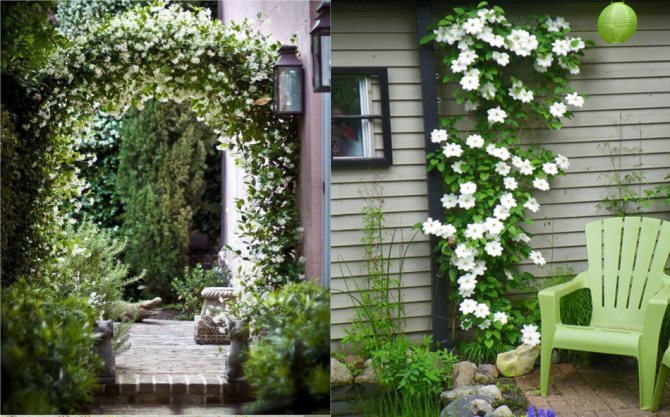

Real jasmine in the courtyards of houses
Since the plant called jasmine in Russia is not, then the superstitions associated with planting this plant on the site can be considered false.
VIDEO: How to tune in to magic?
Interestingly, only a few types of jasmine grown in the Far and Near East are suitable for aromatherapy and magical rituals. Here is a list of these magical properties:
- If a girl puts dried jasmine flowers in a locket, she will inspire confidence and inner beauty in men.
- Jasmine oil, which is applied to the forehead, adds psychic abilities.
- Sachets (bags of dried herbs) are made from dried jasmine petals to attract a loved one.
- Jasmine is believed to attract pure, sincere love.
- Jasmine flowers are used to make "love potions".
- There are rituals for wealth and luck, during which jasmine is burned.
- Burning jasmine flowers in your bedroom will help develop intuition. Some people even believe that in this way you can develop psychic abilities.
Content
- Listen to the article
- Description
- Caring for stephanotis at home How to care
- Pruning stephanotis
- Stephanotis transplant
- Propagation of stephanotis by cuttings
- Insect pests and diseases
Jasmine shrub - what it brings to the house: signs
A jasmine bush near the house is not considered a bad omen. It is considered a bad omen to break his branches and give them to someone or put broken jasmine branches in a vase at home.
- On broken branches of jasmine, flowers turn yellow, wither and fall very quickly.
- Jasmine is considered a "brotherly plant", the branches of both real jasmine and mock-orange diverge at the same angle into two branches equal in thickness.
- Thus, breaking jasmine, we figuratively destroy friendship and bring disagreements into relationships with loved ones. But if you take good care of it, then it will give your home only happiness.
Is it possible to plant jasmine near the house: signs
You can plant jasmine near the house, signs and beliefs of many countries speak about this.
The Tatars even have a legend that before a person goes to heaven, they will ask him if he has grown jasmine.
However, do not confuse jasmine with mock orange. Chubushnik has no superstitions associated with his landing. Jasmine in the East is considered a traditionally female flower. It symbolizes feminine attractiveness and can attract the attention of men. Imagine an evening stroll through an Arabian city, with its sweet heady scent of jasmine and spice.This atmosphere is conducive to love adventures.
Look at the window, in the photo below, looking at it, willy-nilly, the thought arises that a beautiful lady lives behind this window. Whether you need a jasmine near your home, and whether you want to "fight off" the attention of gentlemen, it's up to you.
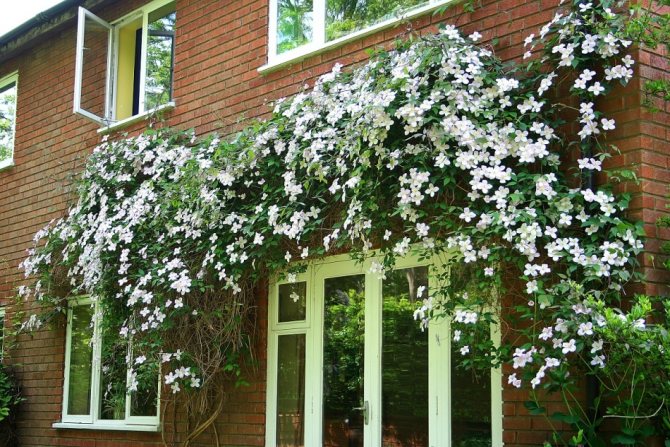

Jasmine near the house signs
Formation of the stephanotis bush


The plant needs minor pruning before replanting. You should also cut off dried inflorescences, thus, the plant will have the strength for growth and development.
The shoots of Stephanotis grow rapidly in length. That is why it is so important to organize the support for the branches in a timely manner or to let them go along the arcuate support. If the flower grows in a greenhouse or in a winter garden, the length of its shoots can reach five or even six meters.
Flower and fruit
The flowering period of indoor stephanotis is summer or early autumn. Flowers in inflorescences about 10 pieces. Madagascar jasmine is a monoecious plant. Artificial pollination should be done with a thin artistic brush, transferring pollen from the stamens of some flowers to the pistils of others.
Important: Do not put a blooming vine in a bedroom or children's room, as long-term inhalation of its scent can cause migraines and discomfort.
Stefanotis fruits ripen for 9 months. The berries can reach 10 cm, at first they are green, then they turn yellow and shrivel. After the seeds ripen, the fruit bursts and the seeds fly out of it. Each fruit has an average of 100 seeds. Each seed has a fluffy parachute with which it can fly away in the wind for a long distance. To preserve the seeds before ripening, a nylon bag must be put on the fruit.
Signs and superstitions
The opinions of superstitious people regarding Stephanotis vary greatly. Up to the point that one omen calls the flower "muzhegon", and the other promises that its flowering foreshadows an early marriage. According to one version, the presence of a plant in the house will provide mutual understanding among household members and eliminate quarrels, according to another, the compilers of reference books recommend isolating the plant from the husband, for example, keeping it in a room where a man rarely enters.
Bioenergy therapists generally recommend having this plant at home.if it is required to reduce the concentration of destructive energies. They believe that it harmonizes space and dampens outbursts of anger.
There is no unequivocal opinion, therefore everyone has the right to decide what signs to believe in.
Views
Let's consider the most popular ones:
- Stefatotis floribunda... The only view adapted to the conditions of the apartment. It has creamy white flowers-stars, 6 cm in diameter.
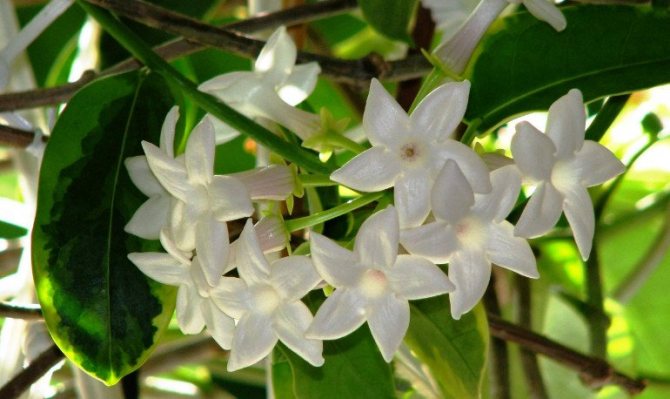

- Stefatotis akuminata... The culture blooms with creamy star-shaped flowers.


- Stefatotis grandiflora... During the flowering period, the liana is covered with large inflorescences, each of which has three dozen greenish flowers.
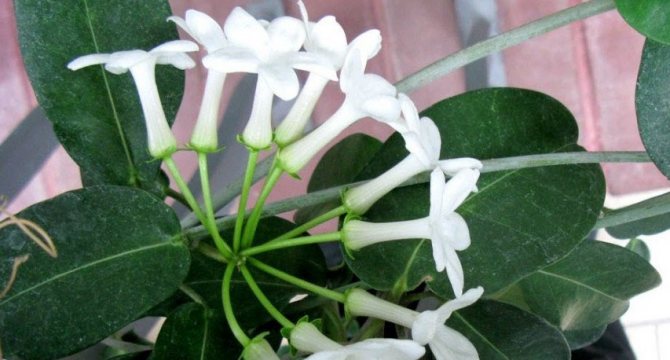

- Stefatotis marginata... Plant with variegated leaves, blooms white, smells good.
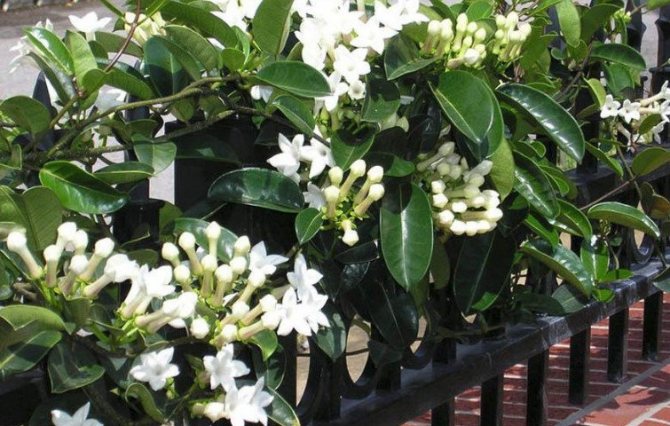

- Stefatotis thorsi (touarsi). It blooms with pale lilac stars with a bright pink throat.
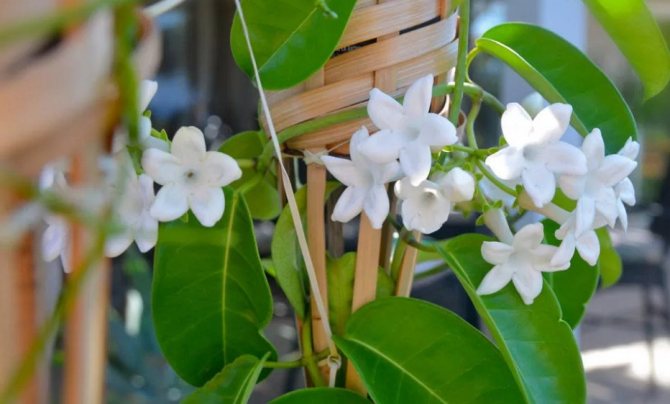

- Stephanotis variegata... A profusely flowering hybrid with white flowers. A distinctive feature of the hybrid is the creamy-white-pinkish variegation of the leaves (areas with different colors due to mutant cells), which are slightly smoothed at the tips.
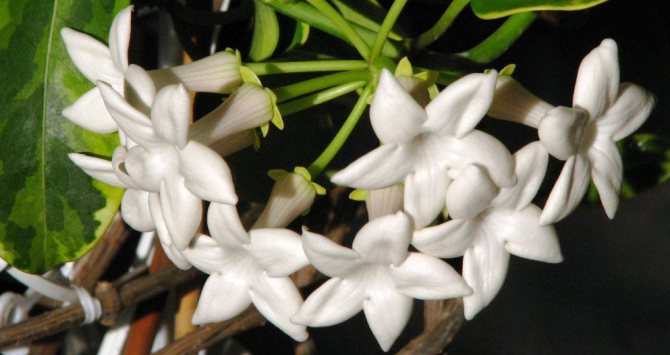

Flowering stephanotis
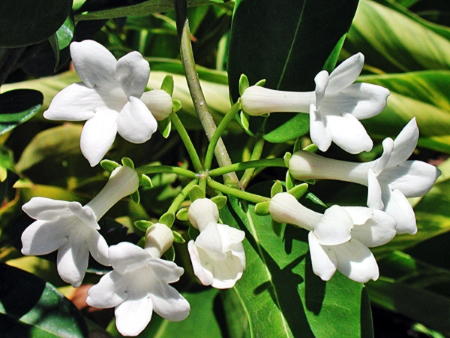

The flowering period of stephanotis begins in the second half of spring and lasts until early autumn. Flowers are the main reason why growers grow a plant. The inflorescences are very delicate, beautiful and fragrant. Flowers, consisting of five curved petals, like wax stars, reach 6 cm in diameter and are collected in bunches of five to seven pieces.
The most common indoor type of Stephanotis is Floribunda. This is a multi-flowered species, on which a lot of rather large buds are formed during the flowering period - up to 6 cm.
It is almost impossible to wait for the formation of fruits on a room stephanotis.
Secrets of the abundant flowering of Stephanotis
- Spray very gently or do not spray at all so that the water does not get on the flowers.
- Do not move or rotate the pot.
- Eliminate temperature drops.
- Remove the flowerpot away from drafts.
- If the air temperature is too high, a small number of buds may form on the shoots. The optimal temperature regime is from +16 to +18 degrees. At night, the temperature can drop to +14 degrees.
Reviews of gardeners about growing Stephanotis
My Stephanotis is 10 years old. The pot is larger than 10 liters. The height of the arc is 1.3 meters. Loves the sun (better in the morning). In the summer it stands on the street. I water abundantly in the summer, and every day in the heat. In winter, once a week.
viniti
I would say that with proper care (light, humidity) it is not a capricious plant at all. The growth rate is amazing, I barely have time to reel on the supports. Mine is also from the "discounted price". It grows for a long time, it blooms.
Alex
I would like to give some tips. 1. There was the first sad experience - I decided to "rejuvenate" the bush, cut it well and the bush disappeared completely. I began to study the literature on the plant and read that it is impossible to cut Stephanotis too much - it will die. 2. This plant reacts to a change in location (especially when it blooms), experienced flower growers advise to mark the pot so as not to change the position of the flower in relation to the light. By the way, the stores sell small bright insects with Velcro for pots, very cute and convenient.
Irene
Stefanotis mine stands all year round on the southern window in full sun. But after winter it is necessary to gradually accustom to the sun. Yesterday I took it off the window sill to water, I look, and he has all the leaves with a slight yellowness, almost imperceptible, but it's immediately clear - they were burnt from the bright spring sun!
Busya
Difficulties in growing
When growing an exotic flower, you can sometimes encounter some problems, for example, lack of flowering, the presence of diseases or damage to the bush by pests.
Why does not it bloom
It happens that at home Madagascar jasmine does not bloom, so the owner of an exotic vine asks the question: what should be done in this case and how to make the capricious Stephanotis bloom? First you need to find out for what reasons the described plant may not throw out color.
Read more about why geranium, Decembrist and anthurium do not bloom.
Among them it is necessary to highlight:
- Temperature drops. It is necessary to provide the plant with comfortable conditions with a temperature of + 18 ... + 25 ° С.
- Insufficient illumination. It is necessary to create conditions for the culture with diffused bright lighting, provide enough free space, increase the duration of daylight hours to 12 hours using artificial lighting.
- Excess nitrogen in the soil mixture. It is necessary to replace the soil in the pot with a potassium and calcium-rich substrate.
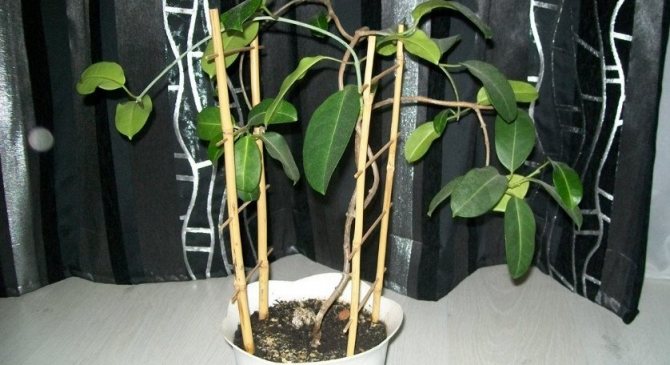

Diseases and pests
Like any indoor plants, the described liana can be subject to diseases and attack by parasites.
Among the diseases, the following are considered common:
- Powdery mildew. To combat the disease, spraying with the "Hom" preparation is used (4 ml of the product are used per 1 liter of water).
- Yellowing or falling foliage. It happens due to a lack of lighting or if the flower needs to be transplanted into a more spacious container.
The pests attacking Stephanotis include:
- Greenhouse aphids. The plant must be treated with "Akarin" bio-agent (4 ml per 1 liter of water). The preparations "Fitoverm" (4 ml per 1 liter of water) and "Actellik" (2 ml per 2 liters of water) will also be effective. Treatment with drugs is carried out 2 times (with an interval of 14 days).
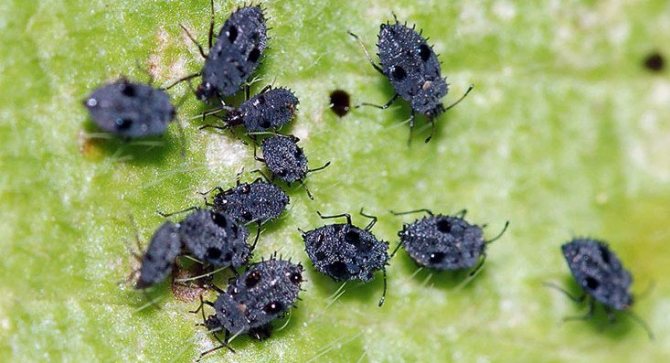

- Spider mite... To combat it, use the "Kleschevit" agent (2 ml per 1 liter of water), with a solution of which the culture is sprayed 2-3 times (with an interval of 10 days).
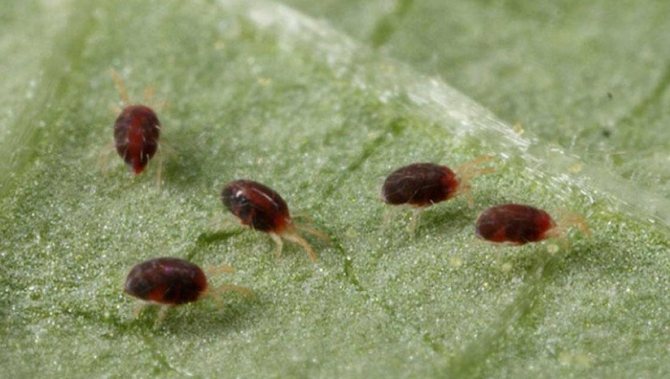

Jasmine - can I keep at home: signs
In Russia, you can hear a sign saying that jasmine "kicks out" men from the house... Perhaps this belief is an echo of the traditions and rituals of the Middle East and Asia. In religious rites jasmine really symbolizes purity and virginity... The image of jasmine is generally very multifaceted, and is interpreted differently in different countries.
Contradicting the image of jasmine as "muzhegon" is that jasmine in the East is considered the strongest aphrodisiac... And in love magic, it is believed that fragrant cushions with dried jasmine flowers, on the contrary, are able to bring harmony to married life and return love attraction to husbands and wives. Therefore, jasmine can be kept at home quite calmly.
Signs
Some signs, superstitions and myths are associated with almost every houseplant. It is believed that, getting into the house, it spreads its energy around. There are also beliefs regarding the Stefanotis flower. According to one of them, this plant protects the woman's house from men (for example, protecting the bride). The other, on the contrary, says that for good care, it will attract a soul mate into the life of the hostess or harmonize existing relationships. And its flowering, which happens extremely rarely, will be a good omen for this. It was not for nothing that it was called “the bride's flower”.
You should not pay special attention to myths and omens around the flower, especially those so contradictory. You just need to remember that this plant with a stunning aroma and exotic look has poisonous juice. This does not affect the household in any way if the poison does not enter the body.
It is necessary to keep Stefanotis out of the reach of children and animals and work with him with gloves.
Stephanotis, reproduction
You can propagate Madagascar jasmine by growing seeds or cuttings.
Seed reproduction of stephanotis
Let's make a reservation right away that growing Stephanotis from seeds is a very difficult task. It is worth taking on it only for those who have a lot of patience and time.
Sowing seeds:
- Soak the seeds in boiled water for 48 hours.
- Take some of the steamed peat and earth, fill the pot with soil, water.
- Deepen the seeds 5 mm into the soil, cover the pot with plastic wrap.
- Place the seed container in a bright and warm room.
- Spray the soil as it dries.
- Remove condensation on the film daily so that not a drop gets on the seedlings. Seedlings will take up to 60 days to germinate.
- When a pair of true leaves is formed on the sprouts, the plants dive into separate pots with soil for Stephanotis.


Reproduction of stephanotis using cuttings
Madagascar jasmine is a difficult-to-root flower, therefore phytohormones must be used in the case of its propagation by cuttings. This is perhaps the only breeding method that allows you to quickly grow a healthy Stephanotis with the genetic traits of the parent.
Cuttings are carried out in the spring-summer season:
- At the time of pruning, several semi-lignified cuttings are selected. Each should have 2-5 leaves.
- Pruning must be carried out just below the node, and then immediately process the bottom of the cutting with Kornevin.
- Then they take a pot and fill it with sand. Cuttings are buried at an angle in the sand. Planting depth 1.5 cm.
- From above, the stalk is covered with a cut plastic bottle. The greenhouse is ventilated daily and the sand is moistened at the same time.
- After 16-20 days, the cuttings take root.
- They take new containers 7-9 cm high, fill them with a suitable substrate and plant young plants.
- The seedlings are kept at + 18⁰C during the day, and + 14⁰C at night.
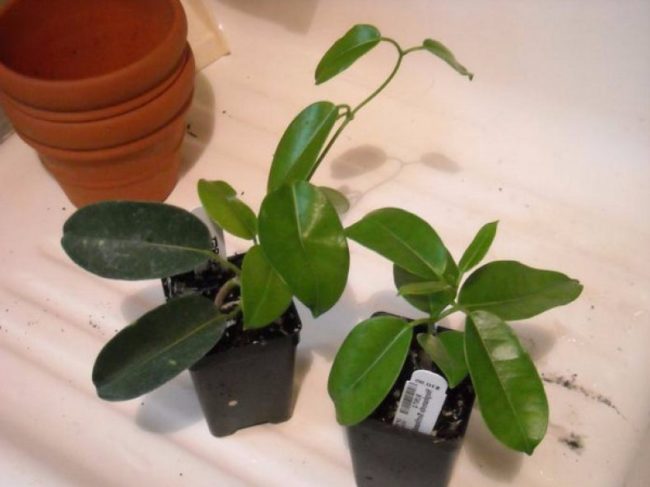

Jasmine flower - how is it used?
Jasmine flower is used:
- Jasmine is considered the national flower Pakistan... On their wedding day, the bride and groom wear garlands of white jasmine and red roses.
- In the Philippines jasmine flowers are used in religious ceremonies.
- Indonesians decorate themselves with jasmine for wedding ceremonies.
- In thailand jasmine is a symbol of mother and it stands for love and respect.
- In the United States jasmine symbolizes romance and success.


Jasmine flowers at the wedding ceremony
Flower photo
In the photo, the plant looks attractive and somewhat resembles succulents, which creates the erroneous impression of its unpretentiousness. In fact, Stephanotis is very picky about care, light and soil quality.
Description of stephanotis
Exotic and vibrant Madagascar is full of surprises. One of them is a magnificent plant called stephanotis. On a tropical island, the flower prefers to grow on forest edges, hiding in partial shade. The first description falls on the distant 1806. Since then, a lot of water has flowed under the bridge, but Stephanotis still remains the most beautiful and desirable plant for flower growers around the world.
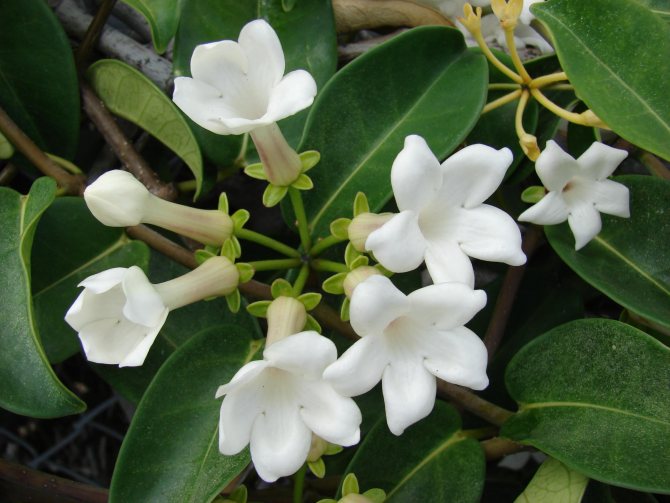

Stephanotis - representative of tropical Madagascar
Stefanotis is a perennial climbing vine that grows up to 6 m in natural conditions. The stem at a young age is elastic and elastic, in an adult plant it is lignified. The leaves have a leathery glossy surface and are painted in a dark emerald color. The shape of the leaf plate resembles a vertically elongated ellipse with a pointed tip 5 to 10 cm long. The central vein is pronounced. The leaves are opposite, attached to the stem with long cuttings.


Stephanotis - climbing vine
The name Stephanotis literally translates as “a crown of ears”.
Beautiful, delicate flowers are the main decoration of a tropical plant. The flowers are tubular, crowned with curved petals that resemble a star. Inflorescences are loose corymbose, axillary type. One bunch contains up to 7 colors. They are painted in white, cream and lilac shades. The unforgettable, enchanting and delicate aroma of Stephanotis gives it a resemblance to jasmine, therefore in the common people this tropical plant is often called Madagascar jasmine. In natural conditions, the duration of flowering lasts 10 long months.


In nature, Stephanotis blooms for 10 months
The delicate white flowers of Stephanotis are often used to create a bridal bouquet, in wedding flower arrangements, and even woven into the bride's hair. For this, Stephanotis is known as the "bride's wreath".
Stefanotis fruits are elliptical-like bolls. There are parachute seeds inside. As soon as the ripe fruit bursts, the seeds will scatter in different directions.
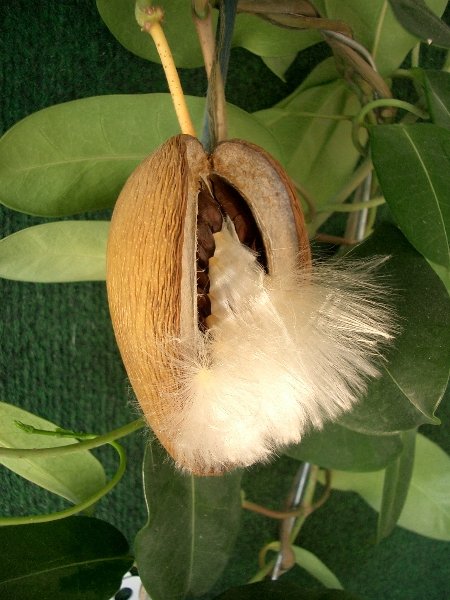

There are parachute seeds inside the stefanotis fruit
If we talk about the difficulty of growing Stephanotis at home, then, of course, you cannot call the plant easy to care for. In order for a tropical flower to feel at home and to develop normally, it needs help and create conditions that resemble natural. A person who is inattentive or very busy will not be able to follow the rules of care. But a patient and loving florist will definitely grow Stephanotis and enjoy its beautiful flowering.



